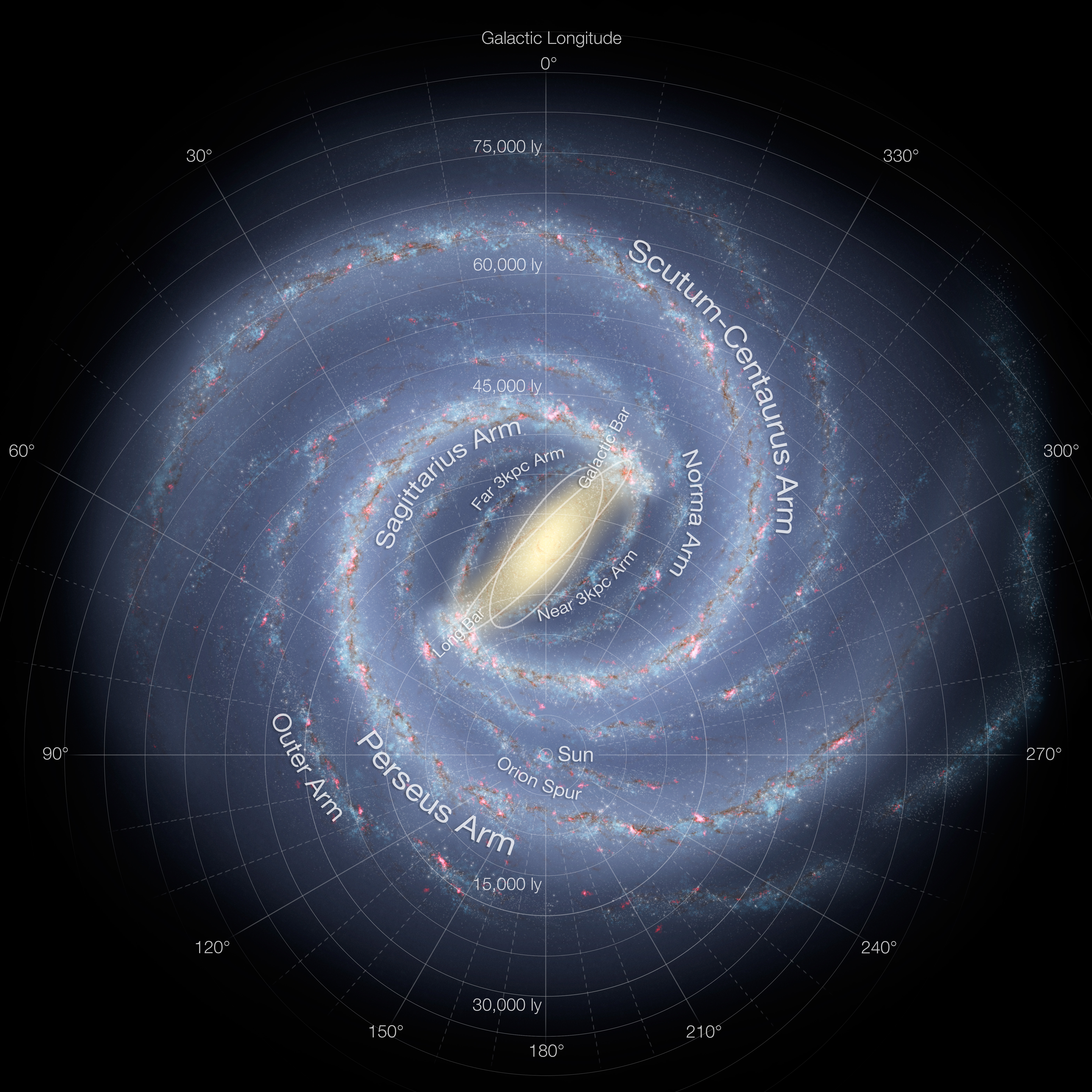Near 3 kpc Arm on:
[Wikipedia]
[Google]
[Amazon]
 The Near 3 kpc Arm (also called Expanding 3 kpc Arm or simply 3 kpc Arm) was discovered in the 1950s by astronomer van Woerden and collaborators through 21-centimeter radio measurements of HI (
The Near 3 kpc Arm (also called Expanding 3 kpc Arm or simply 3 kpc Arm) was discovered in the 1950s by astronomer van Woerden and collaborators through 21-centimeter radio measurements of HI (
T. M. Dame, P. Thaddeus, ''ApJ Letters'', 2008 It was found to be expanding away from the center of the
Press Release Harvard-Smithsonian Center for Astrophysics, 2008 It is named for its distance (more accurately, 3.3 kpc) from the
NASA/Astronomy Picture of the Day, 2008Star formation and ionization in the 3 kiloparsec arm
''Astrophysical Journal'', Part 1, vol. 241, Oct. 1, 1980, p. 200–207 Along with the Far 3 kpc Arm discovered in 2008, these inner arms establish the Milky Way galaxy's simple symmetry.
 The Near 3 kpc Arm (also called Expanding 3 kpc Arm or simply 3 kpc Arm) was discovered in the 1950s by astronomer van Woerden and collaborators through 21-centimeter radio measurements of HI (
The Near 3 kpc Arm (also called Expanding 3 kpc Arm or simply 3 kpc Arm) was discovered in the 1950s by astronomer van Woerden and collaborators through 21-centimeter radio measurements of HI (atomic hydrogen
A hydrogen atom is an atom of the chemical element hydrogen. The electrically neutral atom contains a single positively charged proton and a single negatively charged electron bound to the nucleus by the Coulomb force. Atomic hydrogen constit ...
).A New Spiral Arm of the Galaxy: The Far 3-Kpc ArmT. M. Dame, P. Thaddeus, ''ApJ Letters'', 2008 It was found to be expanding away from the center of the
Milky Way
The Milky Way is the galaxy that includes our Solar System, with the name describing the galaxy's appearance from Earth: a hazy band of light seen in the night sky formed from stars that cannot be individually distinguished by the naked eye ...
at more than 50 km/s
The metre per second is the unit of both speed (a scalar quantity) and velocity (a vector quantity, which has direction and magnitude) in the International System of Units (SI), equal to the speed of a body covering a distance of one metre in ...
. This spiral arm
Spiral galaxies form a class of galaxy originally described by Edwin Hubble in his 1936 work ''The Realm of the Nebulae''solar mass
The solar mass () is a standard unit of mass in astronomy, equal to approximately . It is often used to indicate the masses of other stars, as well as stellar clusters, nebulae, galaxies and black holes. It is approximately equal to the mass ...
es of gas, mostly hydrogen atoms and molecules.Milky Way's Inner Beauty RevealedPress Release Harvard-Smithsonian Center for Astrophysics, 2008 It is named for its distance (more accurately, 3.3 kpc) from the
Galactic Center
The Galactic Center or Galactic Centre is the rotational center, the barycenter, of the Milky Way galaxy. Its central massive object is a supermassive black hole of about 4 million solar masses, which is called Sagittarius A*, a compact rad ...
. It is about 5.2 kpc from the Sun
The Sun is the star at the center of the Solar System. It is a nearly perfect ball of hot plasma, heated to incandescence by nuclear fusion reactions in its core. The Sun radiates this energy mainly as light, ultraviolet, and infrared radi ...
, and is located in the fourth galactic quadrant
A galactic quadrant, or quadrant of the Galaxy, is one of four circular sectors in the division of the Milky Way Galaxy.
Quadrants in the galactic coordinate system
In actual astronomical practice, the delineation of the galactic quadrants ...
.
The last attempt to search for star forming regions in the Near 3 kpc Arm (in 1980) showed little star formation
Star formation is the process by which dense regions within molecular clouds in The "medium" is present further soon.-->interstellar space
occurring in the numerous molecular clouds of this arm.The Far 3kpc ArmNASA/Astronomy Picture of the Day, 2008
''Astrophysical Journal'', Part 1, vol. 241, Oct. 1, 1980, p. 200–207 Along with the Far 3 kpc Arm discovered in 2008, these inner arms establish the Milky Way galaxy's simple symmetry.
See also
*Galactic disc
A galactic disc (or galactic disk) is a component of disc galaxies, such as spiral galaxies and lenticular galaxies. Galactic discs consist of a stellar component (composed of most of the galaxy's stars) and a gaseous component (mostly composed ...
References
{{Portal bar, Stars, Spaceflight, Outer space, Solar System Milky Way arms Galactic astronomy Spiral galaxies